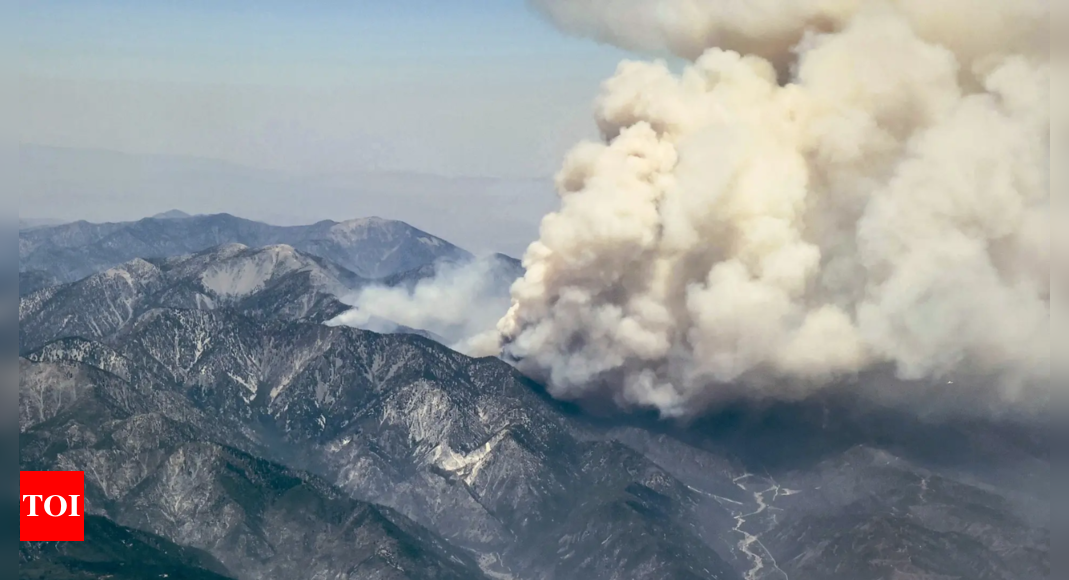
As temperatures soar and humidity levels plummet, authorities in Western states are sounding the alarm about the escalating danger of wildfires. The landscape is becoming increasingly parched due to a prolonged heat wave that is expected to continue baking much of the US on Thursday.
According to Joe Tyler, director of the California department of forestry and fire protection, “We are not just in a fire season, but we are in a fire year.” He emphasised the need for extra caution, as the state has already responded to over 3,500 wildfires this year, which have consumed nearly 325 square miles (842 square kilometres) of vegetation – a staggering five times the average burned through July 10 in each of the past five years.
According to a report from AP, California crews are grappling with at least 19 major wildfires in scorching temperatures and single-digit humidity. One particularly stubborn blaze, spanning 45 square miles (117 square kilometres) in the mountains of Santa Barbara County, has prompted evacuation orders for approximately 200 homes northwest of Los Angeles. The flames are rapidly consuming the tinder-dry brush and grass.
Oregon is also facing several wildfires, with one blaze about 111 miles (178 kilometres) east of Portland expanding to 11 square miles (28 square kilometres) on Wednesday due to high temperatures, strong winds, and low humidity, as reported by the state fire marshal. Governor Tina Kotek has issued an emergency authorisation to deploy additional resources to combat the fires as the state experiences record-breaking daily high temperatures.
The heat wave is affecting more than 142 million people across the US, with dozens of locations in Western states tying or breaking heat records over the weekend and throughout the week. Las Vegas, for example, has recorded its fifth consecutive day of temperatures reaching or exceeding 115 F (46.1 C), breaking the previous record of four consecutive days set in July 2005.
On the East Coast, the weather service has issued warnings of major-to-extreme heat risk in certain areas. An excessive heat warning remains in effect for the Philadelphia area, northern Delaware, and nearly all of New Jersey, with temperatures hovering around 90 F (32.2 C) and the heat index potentially reaching as high as 108 F (42.2 C).
The extreme heat has been linked to several fatalities, including a motorcyclist in California’s Death Valley National Park and a third hiker at the Grand Canyon in recent weeks. In Arizona, authorities are investigating the deaths of a 2-year-old left alone in a hot vehicle and a 4-month-old who died from heat-related complications.
The US heat wave coincides with record-breaking global temperatures in June, marking the 13th consecutive month of record warmth and the 12th straight month that the world was 1.5 degrees Celsius (2.7 degrees Fahrenheit) warmer than pre-industrial times, according to the European climate service Copernicus.
Scientists attribute this trapped heat primarily to human-caused climate change, resulting from the long-term warming effects of greenhouse gases emitted by the burning of fossil fuels.
According to Joe Tyler, director of the California department of forestry and fire protection, “We are not just in a fire season, but we are in a fire year.” He emphasised the need for extra caution, as the state has already responded to over 3,500 wildfires this year, which have consumed nearly 325 square miles (842 square kilometres) of vegetation – a staggering five times the average burned through July 10 in each of the past five years.
According to a report from AP, California crews are grappling with at least 19 major wildfires in scorching temperatures and single-digit humidity. One particularly stubborn blaze, spanning 45 square miles (117 square kilometres) in the mountains of Santa Barbara County, has prompted evacuation orders for approximately 200 homes northwest of Los Angeles. The flames are rapidly consuming the tinder-dry brush and grass.
Oregon is also facing several wildfires, with one blaze about 111 miles (178 kilometres) east of Portland expanding to 11 square miles (28 square kilometres) on Wednesday due to high temperatures, strong winds, and low humidity, as reported by the state fire marshal. Governor Tina Kotek has issued an emergency authorisation to deploy additional resources to combat the fires as the state experiences record-breaking daily high temperatures.
The heat wave is affecting more than 142 million people across the US, with dozens of locations in Western states tying or breaking heat records over the weekend and throughout the week. Las Vegas, for example, has recorded its fifth consecutive day of temperatures reaching or exceeding 115 F (46.1 C), breaking the previous record of four consecutive days set in July 2005.
On the East Coast, the weather service has issued warnings of major-to-extreme heat risk in certain areas. An excessive heat warning remains in effect for the Philadelphia area, northern Delaware, and nearly all of New Jersey, with temperatures hovering around 90 F (32.2 C) and the heat index potentially reaching as high as 108 F (42.2 C).
The extreme heat has been linked to several fatalities, including a motorcyclist in California’s Death Valley National Park and a third hiker at the Grand Canyon in recent weeks. In Arizona, authorities are investigating the deaths of a 2-year-old left alone in a hot vehicle and a 4-month-old who died from heat-related complications.
The US heat wave coincides with record-breaking global temperatures in June, marking the 13th consecutive month of record warmth and the 12th straight month that the world was 1.5 degrees Celsius (2.7 degrees Fahrenheit) warmer than pre-industrial times, according to the European climate service Copernicus.
Scientists attribute this trapped heat primarily to human-caused climate change, resulting from the long-term warming effects of greenhouse gases emitted by the burning of fossil fuels.









